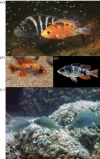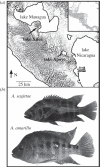Genomics of adaptation and speciation in cichlid fishes: recent advances and analyses in African and Neotropical lineages
- PMID: 22201168
- PMCID: PMC3233715
- DOI: 10.1098/rstb.2011.0247
Genomics of adaptation and speciation in cichlid fishes: recent advances and analyses in African and Neotropical lineages
Abstract
Cichlid fishes are remarkably phenotypically diverse and species-rich. Therefore, they provide an exciting opportunity for the study of the genetics of adaptation and speciation by natural and sexual selection. Here, we review advances in the genomics and transcriptomics of cichlids, particularly regarding ecologically relevant differences in body shape, trophic apparatus, coloration and patterning, and sex determination. Research conducted so far has focused almost exclusively on African cichlids. To analyse genomic diversity and selection in a Neotropical radiation, we conducted a comparative transcriptomic analysis between sympatric, ecologically divergent crater-lake Midas cichlids (Lake Xiloá Amphilophus amarillo and Amphilophus sagittae). We pyrosequenced (Roche 454) expressed sequence tag (EST) libraries and generated more than 178 000 000 ESTs and identified nine ESTs under positive selection between these sister species (Ka/Ks > 1). None of these ESTs were found to be under selection in African cichlids. Of 11 candidate genes for ecomorphological differentiation in African cichlids, none showed signs of selection between A. amarillo and A. sagittae. Although more population-level studies are now needed to thoroughly document patterns of divergence during speciation of cichlids, available information so far suggests that adaptive phenotypic diversification in Neotropical and African cichlids may be evolving through non-parallel genetic bases.
Figures



Similar articles
-
Rapid sympatric ecological differentiation of crater lake cichlid fishes within historic times.BMC Biol. 2010 May 12;8:60. doi: 10.1186/1741-7007-8-60. BMC Biol. 2010. PMID: 20459869 Free PMC article.
-
Local variation and parallel evolution: morphological and genetic diversity across a species complex of neotropical crater lake cichlid fishes.Philos Trans R Soc Lond B Biol Sci. 2010 Jun 12;365(1547):1763-82. doi: 10.1098/rstb.2009.0271. Philos Trans R Soc Lond B Biol Sci. 2010. PMID: 20439280 Free PMC article. Review.
-
Rapid evolution and selection inferred from the transcriptomes of sympatric crater lake cichlid fishes.Mol Ecol. 2010 Mar;19 Suppl 1:197-211. doi: 10.1111/j.1365-294X.2009.04488.x. Mol Ecol. 2010. PMID: 20331780
-
Color assortative mating contributes to sympatric divergence of neotropical cichlid fish.Evolution. 2009 Oct;63(10):2750-7. doi: 10.1111/j.1558-5646.2009.00736.x. Epub 2009 May 28. Evolution. 2009. PMID: 19490078
-
The evolutionary genomics of cichlid fishes: explosive speciation and adaptation in the postgenomic era.Annu Rev Genomics Hum Genet. 2014;15:417-41. doi: 10.1146/annurev-genom-090413-025412. Epub 2014 May 29. Annu Rev Genomics Hum Genet. 2014. PMID: 24898042 Review.
Cited by
-
Transcriptome sequencing of three Ranunculus species (Ranunculaceae) reveals candidate genes in adaptation from terrestrial to aquatic habitats.Sci Rep. 2015 May 20;5:10098. doi: 10.1038/srep10098. Sci Rep. 2015. PMID: 25993393 Free PMC article.
-
Patterns of transcriptome divergence in the male accessory gland of two closely related species of field crickets.Genetics. 2013 Feb;193(2):501-13. doi: 10.1534/genetics.112.142299. Epub 2012 Nov 19. Genetics. 2013. PMID: 23172857 Free PMC article.
-
Genome-Wide Analyses of Thaumatin-like Protein Family Genes Reveal the Involvement in the Response to Low-Temperature Stress in Ammopiptanthus nanus.Int J Mol Sci. 2023 Jan 22;24(3):2209. doi: 10.3390/ijms24032209. Int J Mol Sci. 2023. PMID: 36768531 Free PMC article.
-
Mitogenomic Characterization of Cameroonian Endemic Coptodon camerunensis (Cichliformes: Cichlidae) and Matrilineal Phylogeny of Old-World Cichlids.Genes (Basel). 2023 Aug 6;14(8):1591. doi: 10.3390/genes14081591. Genes (Basel). 2023. PMID: 37628642 Free PMC article.
-
Is ecological speciation a major trend in aphids? Insights from a molecular phylogeny of the conifer-feeding genus Cinara.Front Zool. 2013 Sep 18;10(1):56. doi: 10.1186/1742-9994-10-56. Front Zool. 2013. PMID: 24044736 Free PMC article.
References
-
- Kuraku S., Meyer A. 2008. Genomic analysis of cichlid fish 'natural mutants'. Curr. Opin. Genet. Dev. 18, 551–55810.1016/j.gde.2008.11.002 (doi:10.1016/j.gde.2008.11.002) - DOI - DOI - PubMed
-
- Salzburger W. 2009. The interaction of sexually and naturally selected traits in the adaptive radiations of cichlid fishes. Mol. Ecol. 18, 169–18510.1111/j.1365-294X.2008.03981.x (doi:10.1111/j.1365-294X.2008.03981.x) - DOI - DOI - PubMed
-
- Elmer K. R., Meyer A. 2011. Adaptation in the age of ecological genomics: insights from parallelism and convergence. Trends Ecol. Evol. 26, 298–30610.1016/j.tree.2011.02.008 (doi:10.1016/j.tree.2011.02.008) - DOI - DOI - PubMed
-
- Barluenga M., Stolting K. N., Salzburger W., Muschick M., Meyer A. 2006. Sympatric speciation in Nicaraguan crater lake cichlid fish. Nature 439, 719–72310.1038/Nature04325 (doi:10.1038/Nature04325) - DOI - DOI - PubMed
-
- Seehausen O., et al. 2008. Speciation through sensory drive in cichlid fish. Nature 455, 620–62610.1038/Nature07285 (doi:10.1038/Nature07285) - DOI - DOI - PubMed
Publication types
MeSH terms
LinkOut - more resources
Full Text Sources
Research Materials

